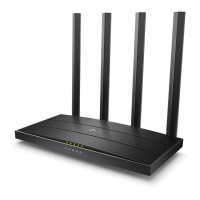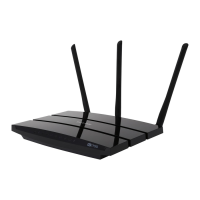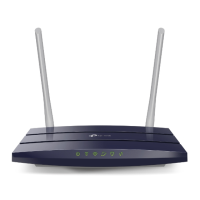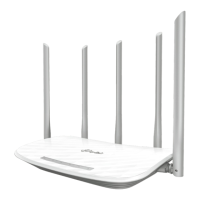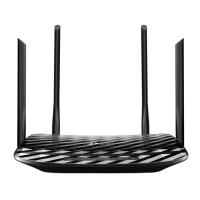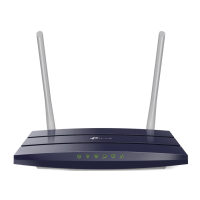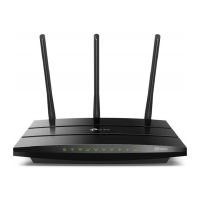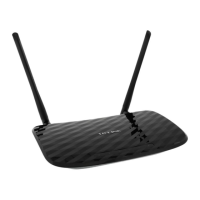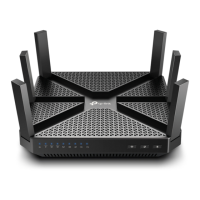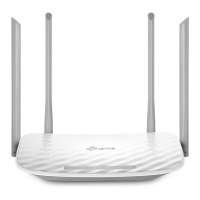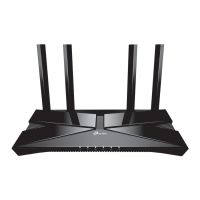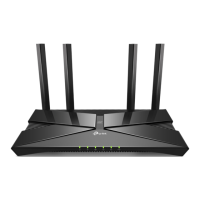Do you have a question about the TP-Link Archer AC1900 and is the answer not in the manual?
Explains document conventions and symbols used in the guide.
Provides links to support resources, apps, and additional guides.
Introduces the router's capabilities and features for SOHO networks.
Describes the router's physical layout and components.
Explains the status and meaning of router LEDs in different modes.
Describes the ports and buttons on the back of the router.
Guidelines for placing the router for optimal performance and safety.
Step-by-step instructions for connecting the router to modem and power.
Instructions on accessing the router's web interface for configuration.
Guides through the automated setup process for internet connection.
Instructions for setting up the router using the TP-Link Tether mobile app.
Details manual configuration for various connection types (Dynamic IP, Static IP, PPPoE).
Configures the router to extend an existing wired network wirelessly.
Configures the router for IPv6 connectivity if provided by ISP.
Steps to create a TP-Link account for cloud services and remote management.
How to update email and password for an existing TP-Link ID.
Adding and removing TP-Link IDs for router management by users.
Using the mobile app for remote router management and monitoring.
Instructions for creating a unified Wi-Fi network with extenders.
Viewing and managing devices within the OneMesh network setup.
Steps to set up a separate Wi-Fi network for visitors.
Configuring permissions and security options for guest networks.
Configuring internet access rules, time limits, and content blocking for child devices.
Setting priority levels for devices/applications and managing bandwidth.
Enabling the SPI firewall for protection against cyber threats.
Blocking or allowing specific devices via MAC address (Blacklist/Whitelist).
Binding IP to MAC addresses to prevent ARP spoofing and attacks.
Configuring Application Layer Gateway (ALG) settings for specific protocols.
Opening specific ports for external access to local network resources.
Automatically opening ports based on connection requests for applications.
Enabling UPnP for seamless online gaming and P2P connections.
Exposing a device to the internet by setting it as a DMZ host.
Modifying the router's local IP address and subnet mask.
Setting up the router for IPTV services, including IGMP and VLAN configurations.
Configuring IP address assignment pool and reservations for client devices.
Configuring DDNS for remote access to the router using a domain name.
Manually configuring routing paths for specific network destinations.
Customizing SSID, password, security, and other wireless parameters.
Setting automatic on/off times for the Wi-Fi network.
Connecting devices using Wi-Fi Protected Setup (WPS) methods.
Fine-tuning wireless parameters like WMM, GI, AP Isolation, and Beacon Interval.
Extending network coverage by bridging the router with an access point.
Updating the router's firmware via auto or online methods.
Saving and loading router configuration settings and factory reset.
Modifying the router's web interface login password.
Controlling device access to the router using MAC address authentication.
Enabling remote access to the router's interface for management.
Protecting the network against cross-site request forgery (CSRF) attacks.
Accessing router event logs for troubleshooting network issues.
Configuring auto-configuration settings (TR-069) for ISP provisioning.
Diagnosing network issues using Ping and Tracert tools.
Configuring system time, time zone, and interface language.
Scheduling automatic router reboots for performance maintenance.
Managing router LED behavior, including enabling Night Mode.
Explains document conventions and symbols used in the guide.
Provides links to support resources, apps, and additional guides.
Introduces the router's capabilities and features for SOHO networks.
Describes the router's physical layout and components.
Explains the status and meaning of router LEDs in different modes.
Describes the ports and buttons on the back of the router.
Guidelines for placing the router for optimal performance and safety.
Step-by-step instructions for connecting the router to modem and power.
Instructions on accessing the router's web interface for configuration.
Guides through the automated setup process for internet connection.
Instructions for setting up the router using the TP-Link Tether mobile app.
Details manual configuration for various connection types (Dynamic IP, Static IP, PPPoE).
Configures the router to extend an existing wired network wirelessly.
Configures the router for IPv6 connectivity if provided by ISP.
Steps to create a TP-Link account for cloud services and remote management.
How to update email and password for an existing TP-Link ID.
Adding and removing TP-Link IDs for router management by users.
Using the mobile app for remote router management and monitoring.
Instructions for creating a unified Wi-Fi network with extenders.
Viewing and managing devices within the OneMesh network setup.
Steps to set up a separate Wi-Fi network for visitors.
Configuring permissions and security options for guest networks.
Configuring internet access rules, time limits, and content blocking for child devices.
Setting priority levels for devices/applications and managing bandwidth.
Enabling the SPI firewall for protection against cyber threats.
Blocking or allowing specific devices via MAC address (Blacklist/Whitelist).
Binding IP to MAC addresses to prevent ARP spoofing and attacks.
Configuring Application Layer Gateway (ALG) settings for specific protocols.
Opening specific ports for external access to local network resources.
Automatically opening ports based on connection requests for applications.
Enabling UPnP for seamless online gaming and P2P connections.
Exposing a device to the internet by setting it as a DMZ host.
Modifying the router's local IP address and subnet mask.
Setting up the router for IPTV services, including IGMP and VLAN configurations.
Configuring IP address assignment pool and reservations for client devices.
Configuring DDNS for remote access to the router using a domain name.
Manually configuring routing paths for specific network destinations.
Customizing SSID, password, security, and other wireless parameters.
Setting automatic on/off times for the Wi-Fi network.
Connecting devices using Wi-Fi Protected Setup (WPS) methods.
Fine-tuning wireless parameters like WMM, GI, AP Isolation, and Beacon Interval.
Extending network coverage by bridging the router with an access point.
Updating the router's firmware via auto or online methods.
Saving and loading router configuration settings and factory reset.
Modifying the router's web interface login password.
Controlling device access to the router using MAC address authentication.
Enabling remote access to the router's interface for management.
Protecting the network against cross-site request forgery (CSRF) attacks.
Accessing router event logs for troubleshooting network issues.
Configuring auto-configuration settings (TR-069) for ISP provisioning.
Diagnosing network issues using Ping and Tracert tools.
Configuring system time, time zone, and interface language.
Scheduling automatic router reboots for performance maintenance.
Managing router LED behavior, including enabling Night Mode.
| WiFi Technology | 802.11ac |
|---|---|
| Dual Band | Yes |
| Processor | 1 GHz Dual-Core |
| Ethernet Ports | 4 x Gigabit LAN, 1 x Gigabit WAN |
| USB Ports | 1 x USB 3.0, 1 x USB 2.0 |
| Antenna | 3 external antennas |
| Beamforming | Yes |
| MU-MIMO | Yes |
| WiFi Speed | 1300 Mbps on 5 GHz + 600 Mbps on 2.4 GHz |
| Memory | 128 MB RAM |
| Security | WPA, WPA2 |
